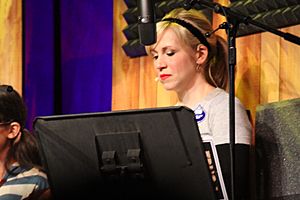Voice-over facts for kids
A voice-over is a special way of using a voice in movies, TV shows, video games, and even commercials. Imagine hearing someone speak, but you don't see them on screen. Their voice plays over the pictures you are watching. It's like a hidden narrator or a character talking without being visible. This technique helps tell stories, explain things, or add feelings to what you see.
Contents
What is a Voice-Over?
A voice-over is when a voice is recorded and then added to a video, animation, or other media. The person speaking is usually not shown on screen. Their voice is heard "over" the images or action. This is different from a character speaking directly on screen, where you see their mouth moving.
How Voice-Overs Work
Voice-overs are created by voice actors who record their lines in a special sound studio. These studios are designed to be very quiet so that only the actor's voice is captured clearly. The recorded voice is then mixed with the other sounds, like music and sound effects, and the visuals of the project.
The Recording Process
Voice actors often read from a script, just like actors in a play or movie. They might also watch the video they are narrating to make sure their voice matches the timing and mood. Sometimes, they have to change their voice to sound like different characters, or to show strong emotions like excitement or sadness.
Where Are Voice-Overs Used?
Voice-overs are everywhere! You hear them all the time, even if you don't always notice. They are a big part of many different types of media.
In Movies and TV Shows
- Narrators: Many movies and TV shows use a voice-over narrator to tell parts of the story. This narrator might be a character looking back on past events or someone who knows everything about the story.
- Documentaries: Voice-overs are very common in documentaries. A narrator's voice explains facts, history, or scientific information while you watch real-life footage.
- Cartoons and Animation: Almost every cartoon character you hear is voiced by a voice actor. These actors bring animated characters to life with their voices, making them sound funny, brave, or even scary.
- Movie Trailers: The exciting voice you hear in movie trailers, telling you about the film, is a voice-over. It's designed to make you want to see the movie!
In Other Media
- Video Games: Voice actors give voices to characters in video games, from heroes to villains and even background characters. This makes games more immersive and exciting.
- Commercials: Many advertisements use voice-overs to describe products or services. The voice might be friendly, trustworthy, or energetic, depending on what the commercial wants to sell.
- Audiobooks: When you listen to an audiobook, you are hearing a voice actor read a book aloud. This is a type of voice-over where the voice tells the entire story.
- Public Announcements: Think about the voices you hear at airports, train stations, or on public transport. These are often pre-recorded voice-overs giving important information.
- Phone Systems: When you call a company and hear an automated voice guiding you through options, that's also a voice-over.
Why Voice-Overs Are Important
Voice-overs are a powerful tool for creators. They can:
- Explain things: They help explain complex ideas or give background information without showing a person talking on screen.
- Set the mood: The tone of a voice-over can make a scene feel happy, sad, mysterious, or exciting.
- Tell stories: They can guide the audience through a story, especially when the visuals alone aren't enough.
- Add personality: In cartoons and video games, voice actors give unique personalities to characters that don't physically exist.
Voice-overs make stories richer and more engaging, helping us understand and connect with what we are watching or listening to.
See also
 In Spanish: Voz en off para niños
In Spanish: Voz en off para niños


